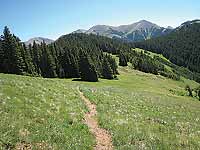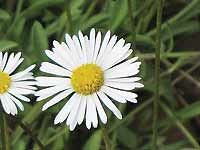At 11,055 feet Gold Knob is one of the lowest and easiest peaks in the La Sal Mountains to climb. Nevertheless with a gain of over 1600 feet, this climb shouldn’t be taken lightly. The double whammy of high elevation and a steady steep grade can take its toll. Now for some good news: the recent construction of a trail to the top makes this hike much easier than it used to be. 
We are lucky to have visions of the La Sal Mountains on our eastern horizon, and even luckier to have this delightful alpine Mecca a short drive away. Consequently my early arrival at Warner Lake will hopefully give me the chance to beat an expected change in the weather. On this quiet morning in early July wind warnings are up, and I am anxious to reach Gold Knob’s summit before the predicted afternoon zephyr breezes in.
At Warner Lake, elevation 9400 feet, the cool air embraces me as I stroll over to get a quick look at Haystack Mountain’s reflection on the serene, blue water of the lake. According to excerpts from the histories of George A. Day and Eli Day, published in volume 41 of The Canyon Legacy, this location was originally called “The Upper Place,” where in the early 1900s Herbert Day set up a dairy farm. He and his wife Mary, along with their twelve children, lived here in the summer to take advantage of the good grazing for their livestock. Up here they also had a ready-made market for their products with residents at Miners Basin, Gold Basin and stockmen who worked in the mountains. In the winter the Day family moved their dairy to the “Lower Place,” now known as Wilson Mesa. 
Herbert Day and the older boys built the Warner Lake dam and ditch for their irrigation system on Wilson Mesa. The lake, however, received the name Warner, after a forest service ranger, who lived there in the early 1930s. The original homestead was abandoned in 1912 leaving nothing except the lake, dam and ditch. Rebuilt in the spring of 1933 by the Civilian Conservation Corps, this system is still used for transporting water from Mill Creek to the reservoir.
The temptation is strong to linger at this idyllic spot, but I’m on a mission to cover ground while I comfortably can. Walking back past the parking area to the billboard, my four-mile round-trip hike begins at the sign for Miners Basin Foot Trail. As I pass through two gates, a refreshing grove of aspens and the richness of blue lupines encompass me. A right turn onto a dirt road is immediately followed by a sharp right marked with an arrow. 
The sun hasn’t arrived yet as I walk through thick stands of Engelmann spruce and firs. Right away the serious upgrade slows me down. At this early hour the dampness and deep shadows provide an uplifting change from the desert heat. Below the path the creek tumbles down a series of playful, mini-sized waterfalls. Eventually I pass by a jumble of loose rock called scree, before stepping over the only stream crossing. Oh how I cherish this lush Garden of Eden. Although the desert blooms are long gone, splendid mountain wildflowers such as blue columbines, red columbines, Richardson geraniums, bluebells and white violets continue to bloom all summer long.
When I reach a transition from deep forest to aspen-lined meadows I see a signed junction – left to stay on the Miners Basin trail or right for the Mountain View trail. Swinging left I start a long series of switchbacks. Now I feel the wind kicking up its heels and I envy a buck in velvet nestled down for a nap. But since I’m almost half way - I’m not turning back now!
 Switchbacks are a nice change from going straight up. Each turn gives me a gentle boost in elevation until I reach another sign to turn for Gold Knob. If I went straight I’d be at the wooded protection at Miners Basin Pass in a matter of minutes. But despite the wind my quest remains Gold Knob, which is still half a mile away.
Switchbacks are a nice change from going straight up. Each turn gives me a gentle boost in elevation until I reach another sign to turn for Gold Knob. If I went straight I’d be at the wooded protection at Miners Basin Pass in a matter of minutes. But despite the wind my quest remains Gold Knob, which is still half a mile away.
In the open meadows, my little venture turns into a hang-onto-your-hat walk. Hefty gusts threaten to flatten the lovely blue flax, cutleaf daisies and blue pentstemon. The aromatic smell of pine mixed with mint fills the air, and the aspen leaves gyrate in a dizzying tossed salad of heart-shaped green. Meanwhile a junco’s high-pitched twill is hard to hear above the wind’s overpowering roar. So much for making it to the top before the big blast hits!
I mark my progress one switchback at a time knowing every step moves me higher until – Phew! - I have reached the top! What a wonderful surprise to discover that on the leeward side the wind isn’t blowing. I am so excited that I can stay much longer than anticipated. The super-charged white-throated swifts, one of the fastest flying birds in North America, like it here, too, as they constantly give me a close buzz. 
Now reaping the rewards of this spectacular panoramic scene, I can see all the way to the Henry Mountains, the Bookcliffs and the Abajos. And down below, there’s Castle Valley, Porcupine Rim, Moab and Behind The Rocks. When I turn my attention to the La Sal peaks I gaze at the prominent presence of Tuk No, Tukuhnikivatz, Mellenthin, Haystack, Manns, Pilot and Green.
An unexpected profusion of wildflowers accompany this dramatic view. It’s amazing how much they thrive at this exposed elevation laying before me a colorful patchwork of parsley, blue penstemon, golden banner pea, blue columbine, scarlet gilia, yarrow and wild roses - a bouquet that attracts a wealth of butterflies and bumblebees. Greedily they work over this bounty of nectar.
Every windblown step of this climb has been worth it, and I am thrilled to be sitting at this marvelous, out-of-the-wind spot with its bird’s eye view. All along I suspected that the end result would justify the drafty walk up!
To get to Warner Lake from Moab go south on Highway 191 for about eight miles before turning left at the sign for the Ken’s Lake-La Sal Loop Road. Then turn right onto Spanish Valley Drive, which quickly becomes the La Sal Loop Road. Drive 14 miles and turn right at the sign for Warner Lake. The five mile dirt road to the lake, which is only open during the summer and early fall, is suitable for any vehicle but be aware that the washboard surface makes for a jouncy ride.



 Switchbacks are a nice change from going straight up. Each turn gives me a gentle boost in elevation until I reach another sign to turn for Gold Knob. If I went straight I’d be at the wooded protection at Miners Basin Pass in a matter of minutes. But despite the wind my quest remains Gold Knob, which is still half a mile away.
Switchbacks are a nice change from going straight up. Each turn gives me a gentle boost in elevation until I reach another sign to turn for Gold Knob. If I went straight I’d be at the wooded protection at Miners Basin Pass in a matter of minutes. But despite the wind my quest remains Gold Knob, which is still half a mile away. 